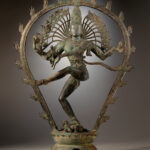
Nataraja (Lord of the Dance) symbol
| Symbol | Nataraja (Lord of the Dance) |
| Religion | Hinduism |
| Origin | Rooted in Tamil and Shaivite traditions. |
| Meaning | Depicts Lord Shiva as the cosmic dancer, symbolizing creation, preservation, and destruction. |
| Appearance | Lord Shiva in a dynamic dance pose, surrounded by a circle of flames. |
| Colors | Often depicted in bronze or symbolic colors. |
| Usage | Icon in temples, symbolizing the cosmic dance of creation. |
| History | Originates in Tamil Nadu and Shaivite philosophy. |
| Popularity | Iconic representation in Hindu art and temples. |
| Importance | Signifies the cosmic cycles of existence and divine energy. |
| Complexity | Detailed symbolism in the pose and accessories. |
| Emotions | Inspires awe, reverence, and an understanding of the cosmic order. |